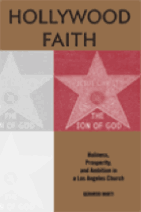NY Times reporter Samuel G. Freedman shows young professional Sikhs participating in amateur-led services as part of the "emerging movement." Today, I caught another intriguing article by the Samuel Freedman on young Sikhs in Manhattan.
Seems they are creating new forms of worship, "youth gurdwara" or youth temple, created by and for young professionals. News of their meetings are spread by word of mouth, email, and social networking sites like Facebook.
 By Getty Images via Daylife
By Getty Images via Daylife
Mandeep Singh remembers his first diwan located in a rented multipurpose room in a luxury condominium:
What most caught Mr. Singh’s eye, though, were the other members of the congregation, or sangat. They were, like him, young professionals, the BlackBerry crowd, and as the worship service, or diwan, proceeded over the next several hours, these amateur clerics took turns leading the chanting of sacred poetry and the singing of devotional hymns.
According to Freedman, this is "the Sikh version of what religion scholars call the emergent movement, a growing trend toward small, nimble, bottom-up, laity-led congregations that especially attract young adults."
 Kanga, Kara and Kirpan - three of the five articles of faith endowed to the Sikhs via Wikipedia
Kanga, Kara and Kirpan - three of the five articles of faith endowed to the Sikhs via Wikipedia
This is "not your chacha’s (in Punjabi, your uncle’s) gurdwara."
On reading about all this, my friend John Schmalzbauer called these "
Sikher sensitive services." Yow!
The article describes how worshipers enter with bare feet and covered head, bow before the holy book, and so fulfill centuries-old obligations. "The service follows the time-honored sequence of readings, hymns, a discourse called katha, the distribution of the sweet sacramental food karah parshad and finally the sharing of a communal meal known as langar.
"But the words of the liturgy are projected from a laptop, both translated into English and transliterated phonetically for the many members who cannot read Gurmukhi, the script of the Sikh religious texts. One set of projections carries the logo 'Sikh to the Max.'”
While a diwan in a conventional gurdwara goes four or five hours, this one finished in two.
Freedman mentions other emergent congregations, evangelical Christian and Jewish ones, but the focus of the article is how 28 year old Singh has become a more religiously active person through this peer-led temple. Being with other young adults seems to motivate attenders.
Freedman notes, "For while news media coverage of Sikhs in the United States has tended to focus on controversy — bias crimes against Sikh men, who are mistaken for Muslims because of their turbans, or civil rights suits by Sikhs to allow men to wear turbans and keep beards in various workplaces — the more prevalent, day-in-day-out experience is of finessing the balance between accomplishment and assimilation."
"Balance between accomplishment and assimilation..." Nicely said.
 By eyesplash Mikul via Flickr
By eyesplash Mikul via Flickr
Another attender Amit S. Guleria said, “When you’re living the life of someone in your 20s, it gives you a different energy.” He added, “When you go to a traditional gurdwara, you feel more like an observer than a participant. Here, the onus is on us. And that’s a responsibility we want to have.”
Who are these 20 somethings? "Well-educated and upwardly mobile... the diwan includes doctors, lawyers, bankers, engineers, computer consultants, graduate students and at least one chef. Perhaps half are the American-born children of immigrants, half are immigrants themselves...
Either way they have a foot apiece in tradition and dynamism."





















